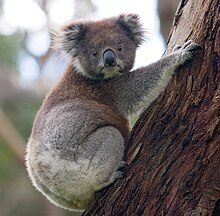Vombatiformes
| Vombatiformes Temporal range:
| |
|---|---|

| |
| Phascolarctos cinereus | |
| Scientific classification | |
| Domain: | Eukaryota |
| Kingdom: | Animalia |
| Phylum: | Chordata |
| Class: | Mammalia |
| Infraclass: | Marsupialia |
| Order: | Diprotodontia |
| Suborder: | Vombatiformes Burnett, 1830 |
| Families | |
The Vombatiformes are one of the three suborders of the large marsupial order Diprotodontia. Five of the seven known families within this suborder are extinct; only the families Phascolarctidae, with the koala, and Vombatidae, with three extant species of wombat, survive.
Among the extinct families are the Diprotodontidae, which includes Diprotodon, believed by many to be the inspiration for the bunyip. "Vombatiformes" is neo-Latin for "wombat-shaped things", and took its name from its type family.
The suborder Vombatiformes, with its closely related members and their compact body form, contrasts with the other two diprotodont suborders, the Macropodiformes: kangaroos, wallabies, and quokkas; and the Phalangeriformes: possums, including the gliders such as the wrist-winged gliders. The koala and wombats are believed by many biologists to share a common ancestor and to have diverged only recently in the Cenozoic.
Classification
Suborder Vombatiformes
- Family Vombatidae: wombats (three modern species)
- Genus †Rhizophascolomus
- Genus Vombatus
- Genus †Phascolonus
- Genus †Warendja
- Genus †Ramasayia
- Genus Lasiorhinus
- Family Phascolarctidae: koala (one modern species)[1]
- Genus †Perikoala
- Genus †Madakoala
- Genus †Koobor
- Genus †Litokoala
- Genus †Nimiokoala
- Genus Phascolarctos
- Family †Ilariidae
- genus †Nimbadon
- Genus †Koalemas
- Genus †Kuterintja
- Genus †Ilaria
- Family †Maradidae
- Family †Thylacoleonidae: marsupial lions.[3]
- Genus †Thylacoleo
- Genus †Priscileo
- Genus †Wakaleo
- Family †Wynyardiidae
- Genus †Wynyardia
- Genus †Muramura
- Genus †Namilamadeta
- Superfamily Diprotodontoidea[4]
- Family †Diprotodontidae: giant wombats[4]
- Genus †Alkwertatherium
- Genus †Bematherium
- Genus †Pyramios
- Genus †Nototherium
- Genus †Meniscolophus
- Genus †Euryzygoma
- Genus †Diprotodon
- Genus †Euowenia
- Genus †Sthenomerus
- Subfamily †Zygomaturinae[4]
- Genus †Silvabestius
- Genus †Neohelos[4]
- Genus †Raemeotherium
- Genus †Plaisiodon
- Genus †Zygomaturus
- Genus †Kolopsis[4]
- Genus †Kolopsoides
- Genus †Hulitherium
- Genus †Maokopia
- Family †Palorchestidae: marsupial tapirs[4]
- Genus †Palorchestes
- Genus †Propalorchestes
- Genus †Ngapakaldia
- Genus †Pitikantia
- Family †Diprotodontidae: giant wombats[4]
References
- Groves, C. P. (2005). Wilson, D. E.; Reeder, D. M. (eds.). Mammal Species of the World: A Taxonomic and Geographic Reference (3rd ed.). Baltimore: Johns Hopkins University Press. pp. 43–44. ISBN 0-801-88221-4. OCLC 62265494.
- ^
McKenna, Malcolm C.; Bell, Susan K., eds. (1997). Classification of mammals – above the species level. New York: Columbia University Press. pp. xii–631. ISBN 9780231110129.
{{cite book}}:|first2=has generic name (help)CS1 maint: multiple names: authors list (link) - ^ BLACK, K., March 2007. Maradidae: a new family of vombatomorphian marsupial from the late Oligocene of Riversleigh, northwestern Queensland. Alcheringa 31, 17-32. ISSN 0311-5518
- ^ Naish, Darren. "Of koalas and marsupial lions: the vombatiform radiation, part I". Scientific American. Scientific American, Inc. Retrieved 24 October 2015.
- ^ a b c d e f Black, K. (2012). "Revision in the marsupial diprotodontid genus Neohelos: Systematics and biostratigraphy". Acta Palaeontologica Polonica. doi:10.4202/app.2012.0001.
